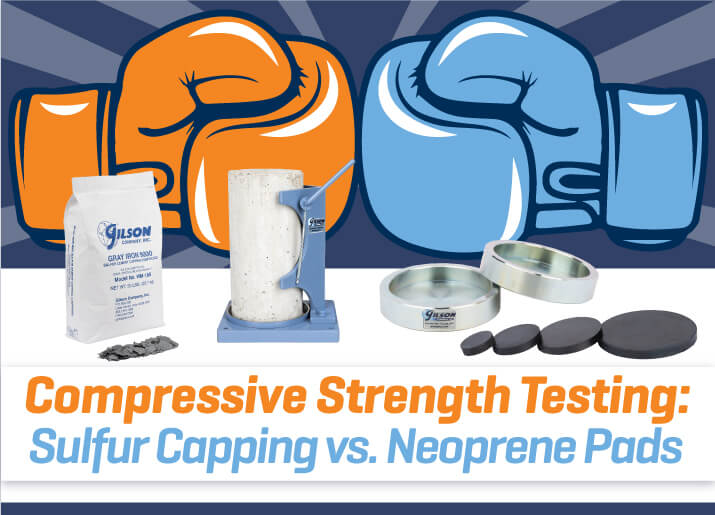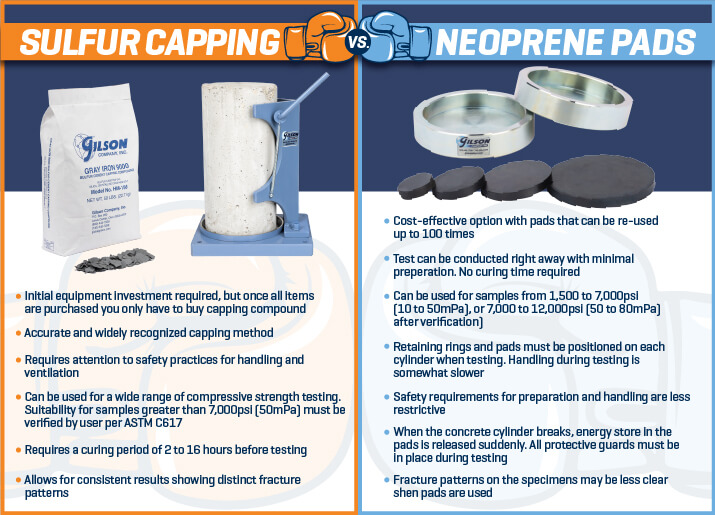
Importance of Capping
Prior to performing compressive strength tests on cylindrical concrete specimens, it’s important to understand both of the most popular options for preparing the cylinder ends. Proper end preparation ensures that the ends of concrete test cylinders or cores have smooth, parallel bearing surfaces perpendicular to the applied axial load to ensure uniform distribution of forces during testing.
ASTM C617 covers methods using molten sulfur mortar, neat cement, or high-strength gypsum paste to form bonded caps. ASTM C1231 specifies the procedure to use unbonded neoprene pads in metal retaining rings. No matter which method you choose, specific criteria should comply with ASTM C39 specifications for the planeness and perpendicularity of specimens. Be sure to scroll down below the infographic for a brief overview of each method as well as the necessary equipment.

Sulfur Mortar Capping
Overview:
Capping of concrete cylinders and drilled concrete cores with sulfur mortar or other capping compounds prepares specimens for compressive strength testing. Specifically, this procedure provides plane surfaces perpendicular to the specimen axis to evenly distribute loading forces. As noted in ASTM C617, sulfur mortar may be used to test specimens with greater compressive strengths than its own after a user verification process. When using the sulfur capping method, it’s important to periodically check for voids by tapping hardened caps with the edge of a coin and listening. Capped cylinders must cure for at least two hours prior to testing or for 16 hours if the design strength is 5,000psi (35MPa) or greater.
Equipment:
- Sulfur Mortar Capping Compound:
- Flake Style, supplied in 50lb bags and often higher in strength
- Ingots sometimes preferred for ease of handling and storage
- Melting pot to prepare capping compound. Capacities from 4 to 28qt (3.8 to 26.5L) are available
- Ladle for transferring molten capping compound
- Cylinder Capper positions cylinders properly for insertion into the compound and during hardening
- The Dial Thermometer ensures the temperature of the compound is between 265° and 290°F (130° to 145°C)
- Gloves and Eye Protection promote safety during capping
Neoprene Pads and Metal Retaining Rings
Overview:
Neoprene Pads or Pad Caps are ideal for tests between 1,500 and 7,000psi, and can also be used for concrete strengths up to 12,000psi with proper verification by the user as noted in ASTM C1231. These pads spread the compressive force evenly across specimen surfaces. The durometer hardness of neoprene pads must be matched to the design strength range of the concrete.
| Diameter, in (mm) | PSI (mPa) | Durometer | Neoprene Pads (Sold Individually) |
|---|---|---|---|
| 6 (152.4) | 1,500–6,000 (10–40) | 50 | HM-363 |
| 4 (101.6) | HM-360 | ||
| 3 (76.2) | HM-366 | ||
| 2 (50.8) | HM-369 | ||
| 6 (152.4) | 2,500–7,000 (17–50) | 60 | HM-364 |
| 4 (101.6) | HM-361 | ||
| 3 (76.2) | HM-367 | ||
| 6 (152.4) | 4,000–7,000 (28–50) | 70 | HM-365 |
| 4 (101.6) | HM-362 | ||
| 3 (76.2) | HM-368 | ||
| 2 (50.8) | HM-370 | ||
| 6 (152.4) | 7,000–12,000 (50–80) | 70 | HM-365 |
| 4 (101.6) | HM-362 | ||
| 3 (76.2) | HM-368 | ||
| 2 (50.8) | HM-370 |
Note: Neoprene pads used to test concrete with design strengths from 7,000 to 12,000psi (50 to 80 mPa) must be qualified by the user, as noted in ASTM C1231.
Equipment:
- Neoprene pads evenly distribute compressive force
- Retainer rings are placed on both ends of concrete cylinders and confine pads, so they do not extend beyond the specimen diameter
- Polysaccharide powder serves as a lubricant for easy pad-change out
- Gloves promote safety during testing
Whether you use the sulfur mortar capping method or neoprene pads with metal retainer rings, proper end preparation guarantees that concrete test cylinder ends or cores have smooth, parallel bearing surfaces for uniform distribution of forces during testing.
Gilson Is Here to Help
Contact our testing experts for more information or to discuss your testing application.
Testing Resources
Standard Test Methods, Specifications, and Practices
Individual test methods and specifications referenced in our product descriptions, blog articles, and videos are available for review or purchase from the professional organizations noted.
- ASTM International (American Society for Testing and Materials)
- AASHTO (American Association of State Highway and Transportation Officials)
- ACI (American Concrete Institute)
- State DOTs (Departments of Transportation)
- ISO (International Organization for Standardization)
- BS (British Standards)
- EN (European Standards)

















